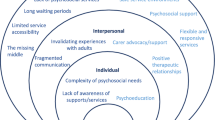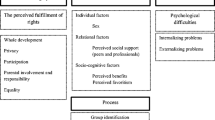Abstract
The evaluation and identification of needs profiles for youth in residential care, through qualitative and quantitative methodologies involving different stakeholders, are still relatively uncommon, even though they are essential in developing specific and effective services. This article will present two studies, one with youth and another with professionals. To assess needs from the standpoint of youth, four focus groups were held with youth in residential care (n = 21). To identify needs profiles of youth from the standpoint of professionals, 47 professionals evaluated a sample of youth in residential care (n = 110) using the RCYNA questionnaire. The results of the study with youth point to needs in three main areas: living situation, social and family relationships, and education. The results of the study with professionals reveal three needs profiles with distinct risk levels: low risk, without emerging needs; intermediate risk, with needs in terms of the economic and living situation; and high risk, with needs in terms of relationships, behavioural, psychological and emotional skills, and education and employment.
Similar content being viewed by others
References
Aguilar-Vafaie, M. E., Roshani, M., Hassanabadi, H., Masoudian, Z., & Afruz, G. A. (2011). Risk and protective factors for residential foster care adolescents. Children and Youth Services Review, 33, 1–15.
Axford, N. (2008). Conducting needs assessments in children’s services. British Journal of Social Work, 40, 4–25.
Axford, N. (2009). Developing congruent children’s services to improve child wellbeing. Child & Family Social Work, 14, 35–44.
Axford, N., Green, V., Kalsbeek, A., Morpeth, L., & Palmer, C. (2009). Measuring children’s needs: How are we doing? Child & Family Social Work, 14, 243–254.
Axford, N., & Little, M. (2004). Meeting needs or protecting rights: Which way for children services?. Totnes: Dartington Social Research Unit.
Axford, N., Little, M., Morpeth, L., & Weyts, A. (2005). Evaluating children’s services: Recent conceptual and methodological developments. British Journal of Social Work, 35, 73–88.
Axford, N., & Whear, R. (2008). Measuring and meeting the needs of children in the community: Survey of parents on a housing estate in Dublin, Ireland. Child Care in Practice, 14, 331–353.
Bailey, S., Thoburn, J., & Wakeham, H. (2002). Using the ‘Looking After Children’ dimensions to collect aggregate data on well-being. Child & Family Social Work, 7, 189–201.
Bardin, L. (2007). Análise de conteúdo. Lisboa: Edições 70.
Bullock, R., Little, M., & Millham, S. (1993). Residential care for children: A review of research. London: HMSO.
Calheiros, M. M., Lopes, D., & Patrício, J. N. (2011). Assessment of the needs of youth in residential care: Development and validation of an instrument. Children and Youth Services Review, 33, 1930–1938.
Cargo, M., & Mercer, S. (2008). The value and challenges of participatory research: Strengthening its practice. Annual Review of Public Health, 29, 325–350.
Clark, A., & Moss, P. (2001). Listening to young children: The Mosaic approach. London: National Children’s Bureau.
Courtney, M. E., & Dworsky, A. (2006). Early outcomes for young adults transitioning from out-of-home care in the USA. Child and Family Social Work, 11, 209–219.
Darbyshire, P., Muir-Cochrane, E., Fereday, J., Jureidini, J., & Drummond, A. (2006). Engagement with health and social care services: Perceptions of homeless young people with mental health problems. Health and Social Care in the Community, 14, 553–562.
Dartington Social Research Unit. (1998). Towards a common language. Totnes: Dartington Social Research Unit.
Del Valle, J. F. (1998). Manual de programación y evaluación para los centros de protección a la infancia. Valladolid: Servicio de Publicaciones de la Junta de Castilla y León.
Del Valle, J. F., Bravo, A., Alvarez, E., & Fernanz, A. (2008). Adult self-sufficiency and social adjustment in care leavers from children’s homes: A long-term assessment. Child and Family Social Work, 13, 12–22.
Department of Health. (1995). Looking after children: Assessment and action records, essential information records, care plans, placement plans and review forms. London: HMSO.
Department of Health. (2000). Framework for the assessment of children in need and their families. London: The Stationery Office Ltd.
Department of Health. (2002). Integrated children’s system working with children in need and their families. London: Consultation Document.
Dworsky, A., & Courtney, M. E. (2009). Homelessness and the transition from foster care to adulthood. Child Welfare, 88, 23–56.
Freundlich, M., Avery, R. J., & Padgett, D. K. (2007). Preparation of youth in congregate care for independent living. Child and Family Social Work, 12, 64–72.
Geenen, S., & Powers, L. E. (2007). “Tomorrow is another problem” The experiences of youth in foster care during their transition into adulthood. Children and Youth Services Review, 29, 1085–1101.
Green, R. S., & Ellis, P. T. (2007). Linking structure, process, and outcome to improve group home services for foster youth in California. Evaluation and Program Planning, 30, 307–317.
Hagaman, J., Trout, A., Chmelka, M., Thompson, R., & Reid, R. (2010). Risk profiles of children entering residential care: A cluster analysis. Journal of Child and Family Studies, 19, 525–535.
Heinze, H. J., Jozefowicz, D. M. H., & Toro, P. A. (2010). Taking the youth perspective: Assessment of program characteristics that promote positive development in homeless and at-risk youth. Children and Youth Services Review, 32, 1365–1372.
Hill, C. E., Thompson, B. J., & Williams, E. N. (1997). A guide to conducting consensual qualitative research. The Counseling Psychologist, 25, 517–572.
Holland, S. (2009). Listening to children in care: A review of methodological and theoretical approaches to understanding looked after children’s perspectives. Children and Society, 23, 226–235.
Horwath, J., Hodgkiss, D., Kalyva, E., & Spyrou, S. (2011). You respond. Promoting effective project participation by young people who have experienced violence. A guide to good practice through training and development. Retirado de http://www.you-respond.eu/files/you-respond-practical-guide-english.pdf.
ISS. (2009). Plano de intervenção imediata. Relatório de caracterização das crianças e jovens em situação de acolhimento em 2008. Lisboa: Instituto da Segurança Social.
Jones, H., Clarke, R., Kufeldt, K., & Norman, M. (1998). Looking after children: Assessing outcomes in child care. The experience of implementation. Children and Society, 12, 212–222.
Kalafat, J., & Illback, R. (1998). A qualitative evaluation of school-based family resource and youth service centers. American Journal of Community Psychology, 26, 573–604.
Kaufman, J., Crusto, C., Quan, M., Ross, E., Friedman, S., O’Rielly, K., et al. (2006). Utilizing program evaluation as a strategy to promote community change: Evaluation of a comprehensive, community-based, family violence initiative. American Journal of Community Psychology, 38, 191–200.
Keller, T. E., Cusick, G. R., & Courtney, M. E. (2007). Approaching the transition to adulthood: Distinctive profiles of adolescents aging out of the child welfare system. Social Service Review, 81, 453–484.
Lemon, K., Hines, A. M., & Merdinger, J. (2005). From foster care to young adulthood: The role of independent living programs in supporting successful transitions. Children and Youth Services Review, 27, 251–270.
Little, M., Axford, N., & Morpeth, L. (2004). Risk and protection in the context of services for children in need. Child and Family Social Work, 9, 105–118.
Little, M., & Mount, K. (1999). Prevention and early intervention with children in need. Cambridge: Ashgate Publishing.
Mares, A. (2010). An assessment of independent living needs among emancipating foster youth. Child and Adolescent Social Work Journal, 27, 79–96.
Massey, O. T. (2011). A proposed model for the analysis and interpretation of focus groups in evaluation research. Evaluation and Program Planning, 34, 21–28.
McCoy, H., McMillen, J., & Spitznagel, E. (2008). Older youth leaving the foster care system: Who, what, when, where, and why? Children and Youth Services Review, 30, 735–745.
Melamid, E., & Brodbar, G. (2003). Matching needs and services: An assessment tool for community-based service systems. Child Welfare, 82, 397–412.
Milburn, N., Liang, L. J., Lee, S. J., Rotheram-Borus, M. J., Rosenthal, D., Mallet, S., et al. (2009). Who is doing well? A typology of newly homeless adolescents. Journal of Community Psychology, 37, 135–147.
Official Gazette. (2007). Despacho nº 8393/2007. Diário da República, 2ª Série, Nº 90, 12279.
Osgood, D. W., Foster, E. M., & Courtney, M. E. (2010). Vulnerable populations and the transition to adulthood. The Future of Children, 20, 209–229.
Reviere, R., Berkowitz, S., Carter, C., & Ferguson, C. (1996). Introduction: Setting the stage. In R. Reviere, S. Berkowitz, C. Carter, & C. Ferguson (Eds.), Needs assessment: A creative and practical guide for social scientists. Washington, DC: Taylor & Francis.
Southwell, J., & Fraser, E. (2010). Young people’s satisfaction with residential care: Identifying strengths and weaknesses in service delivery. Child Welfare, 89, 209–228.
Stein, M. (1994). Leaving care, education, and career trajectories. Oxford Review of Education, 20, 349–360.
Stein, M. (2006a). Research review: Young people leaving care. Child and Family Social Work, 11, 273–279.
Stein, M. (2006b). Missing years of abuse in children’s homes. Child and Family Social Work, 11, 11–21.
Stein, M. (2006c). Young people aging out of care: The poverty of theory. Children and Youth Services Review, 28, 422–434.
Stein, M. (2008). Resilience and young people leaving care. Child Care in Practice, 14, 35–44.
Stein, M. (2012). What is care for? A research perspective. Educational Journal, 134, 8–10.
Stein, M., & Dumaret, A. C. (2011). The mental health of young people aging out of care and entering adulthood: Exploring the evidence from England and France. Children and Youth Services Review, 33, 2504–2511.
Strolin-Goltzman, J., Kollar, S., & Trinkle, J. (2010). Listening to voices of children in foster care: Youths speak out about child welfare workforce turnover and selection. Social Work, 55, 47–53.
Sulimani-Aidan, Y., & Benbenishty, R. (2011). Future expectations of adolescents in residential care in Israel. Children and Youth Services Review, 33, 1134–1141.
Swenson, C., & Chaffin, M. (2006). Beyond psychotherapy: Treating abused children by changing their social ecology. Aggression and Violent Behavior, 11, 120–137.
Taylor, K. (2005). Understanding communities today: Using matching needs and services to assess community needs and design community-based services. Child Welfare, 84, 251–264.
Thompson, S. J., McManus, H., Lantry, J., Windsor, L., & Flynn, P. (2006). Insights from the street: Perceptions of services and providers by homeless young adults. Evaluation and Program Planning, 29, 34–43.
Ward, A. (2004). Towards a theory of the everyday: The ordinary and the special in daily living in residential care. Child & Youth Care Forum, 33(3), 209–225.
Wilson, L., & Conroy, J. (1999). Satisfaction of children in out-of-home care. Child Welfare, 78, 53–68.
Author information
Authors and Affiliations
Corresponding author
Rights and permissions
About this article
Cite this article
Calheiros, M.M., Patrício, J.N. Assessment of Needs in Residential Care: Perspectives of Youth and Professionals. J Child Fam Stud 23, 461–474 (2014). https://doi.org/10.1007/s10826-012-9702-1
Published:
Issue Date:
DOI: https://doi.org/10.1007/s10826-012-9702-1




